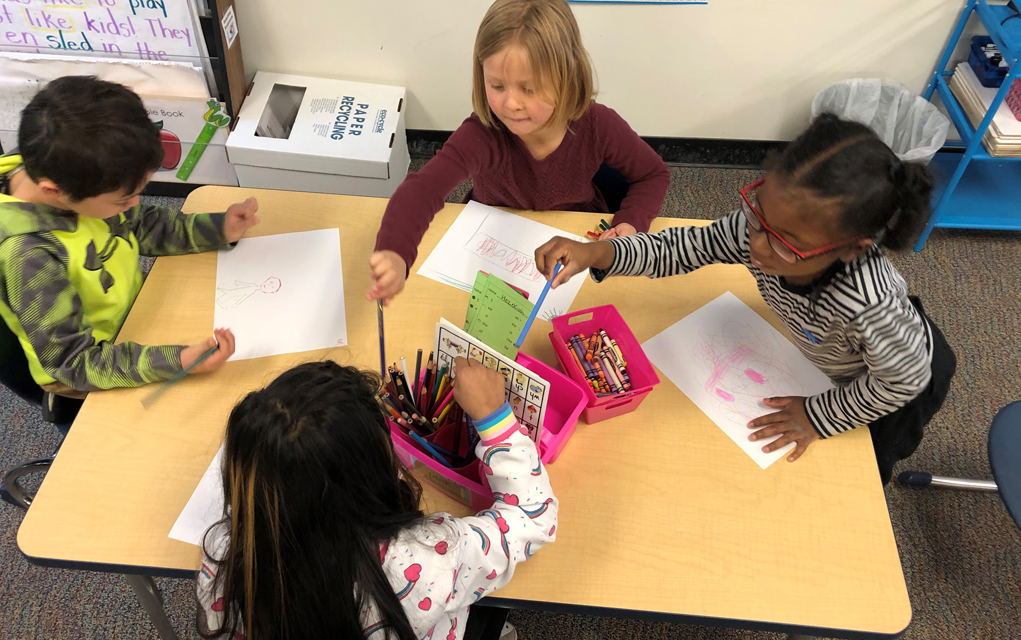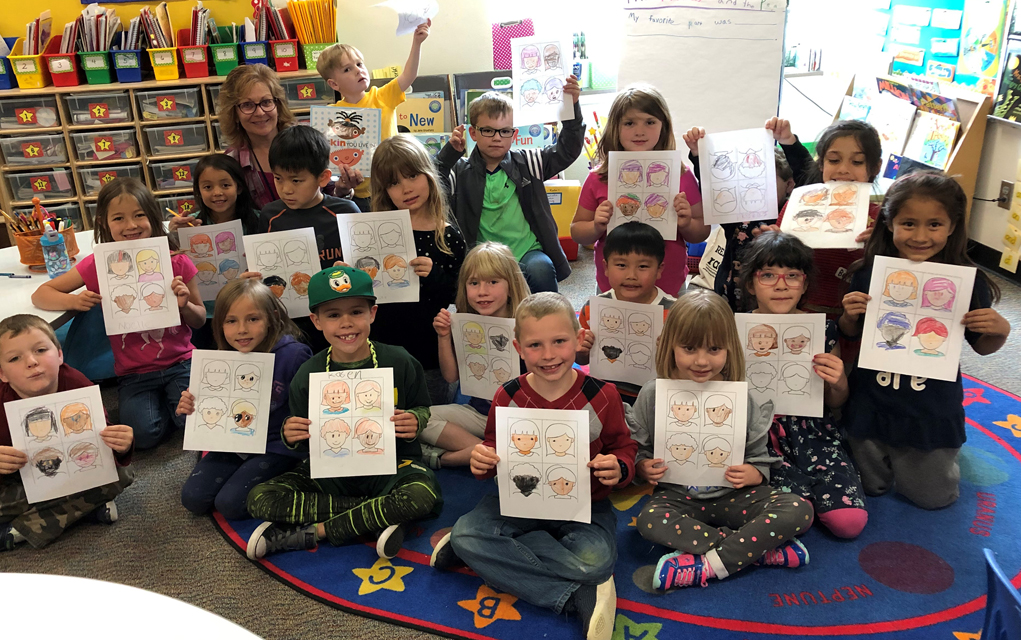
Several years ago, as James Johnson was walking around Costco, a little girl came up to him, touched his arm and said, “You’re black.” Johnson, a native Coloradan and a plumber in Boulder for the last 37 years, was more or less unfazed. “Yeah, I am,” he responded, aware that the girl’s mother appeared mortified.
Then the girl asked: “Does it hurt?”
“And she got me on several levels there ’cause I thought, well sometimes yeah, sometimes it does,” Johnson says. “But she was a sweetheart, she wasn’t being judgmental, she wasn’t trying to make a statement. She just wanted to know. So I just said, ‘Not really, it’s just the color of my skin.’”
It’s conversations like this that inspired Johnson to get involved with the Reading to End Racism (RER) program in local schools more than 15 years ago. Now, the growing program has more volunteer readers than ever, seeking to engage students around Boulder County in conversations about not only racism, but also prejudice, bias, stereotypes, discrimination, privilege and bullying.
“Kindergarteners and first graders, they know what racism is. They’ll say, ‘It’s not being nice to people who have a different skin color,’” says Lucy Ewing, manager of community engagement and equity at the YWCA Boulder County. But the RER curriculum goes beyond this basic definition. “This is more, you know, it’s OK to be different in any way.”
RER began as a nonprofit in partnership with Boulder Valley School District (BVSD) in 1998, but was incorporated into the YWCA in 2013, as part of the organization’s commitment to “eliminating racism.” The program trains volunteer readers to go into BVSD elementary and middle school classrooms and facilitate a conversation around a book they read out loud.
As a teacher at BVSD for 20 years, Ewing organized Martin Luther King Jr. assemblies, sponsored the Anne Frank contest and taught civil rights in the context of fifth grade U.S. history and government. What she likes about the RER program is that it contextualizes these topics, taking them out of the history lesson and into the present.
“It’s a supportive initiative that’s really allowing young students to become more exposed not only to racism as part of the past within our country but … leading students to make connections with their lives here in Boulder County,” adds Ari Gerzon-Kessler, director of the office of equity and partnerships at BVSD.
RER visits classrooms once a year, and has reached about 30 percent of Kindergarten through fifth grade students by visiting 12 schools and 126 classrooms, Ewing says. The goal is to double that next school year, as well as expand the program into the St. Vrain Valley School District. In the 2018-19 school year, RER volunteers were in BVSD schools about twice a month, with 50 active readers and another 25 or so who have been trained but for whatever reason haven’t had the chance to volunteer yet.
“We’ve been in schools this year that are 95 percent white, 75 percent Latino and the whole range in between,” Ewing says.
Across BVSD, 18 percent of the student population is Latino, 68 percent white and the remaining 14 percent are “a blend of biracial, multiracial, Asian, African American and Native American, in relatively smaller numbers,” Gerzon-Kessler says.
“In a white-dominant community, it’s really valuable that we’re not waiting until middle or high school to really expose students to the different dimensions of race and class and other equity issues,” he says.
YWCA has a large library of children’s books from which volunteer readers can choose, exploring a wide range of topics and discussing prominent leaders of color like the women in Hidden Figures and Cesar Chavez. Ewing curates the collection, researching the best books for teaching the subject, as well as ones that are outdated both in terms of terminology and ideas. For example, the idea that, “If you work hard enough, you’ll make it,” Ewing says, “which is a judgment that’s not quite fair, it’s kind of trying to put a pretty polish on reality.”

The readers’ personal stories are also integral to the curriculum, creating connection points with the kids.
“The children really do respond — 99.9 percent of them are very positive about it because, you know, racism is a form of bullying and they all know what it’s like to be left out and to be bullied,” says volunteer reader Debbie Davia. “I think it empowers them because what we do is, we tell them what they can do. Sometimes you see that spark, that light go on. ‘Oh yeah, I can do something about this.’”
Growing up in Kansas, Davia first saw racism in action when she invited an African-American friend over after school. Her father, who she had only ever known as soft-spoken and kind, “became unglued,” she says. “It was a different person completely.”
“And I saw the damage and that hurt that it did to my friend. And it made me very sad that I couldn’t do anything about it,” she continues. “I made up my mind when I got older, I was going to do something about it.”
Davia, who was treasurer of the nonprofit before it was incorporated into the YWCA, has seen the program grow over the years, with more and more readers and coordinators making it run more efficiently, allowing more readings throughout the school year. “With the state of the world as it is right now, I think people are realizing we really need to do something about this,” she says. “We really need to come together as a society.”
Readers volunteer from all different backgrounds and for all different reasons, Ewing says. There are software engineers, librarians, artists, civil rights attorneys, professors, university students, principals and stay-at-home parents.
Mari Camacho recently got involved after seeing information about the program at the YWCA. The mother of four children, Camacho immigrated to the U.S. from Mexico when she was young, only speaking Spanish at the time.
“With the current administration, they have created an open door for people to feel that it’s OK to put others down that are minorities,” Camacho says. “And that’s really sad because I think we were able to build a lot of bridges [in the past] and pretty much they’ve been destroyed. Now we have to build them again and again. That’s exactly why I’m doing this.”
Through volunteering, Camacho has been able to connect with bilingual students, enabling them to take pride in their cultural heritage as well as stand up for each other. She says the message to the kids is clear: “They’re not alone and we should fight for the cause together. It definitely teaches them to be aware, that if they ever feel threatened that it’s OK to raise your voice.”
The program has also taught Camacho to share her own story, and not be afraid to talk about the discrimination she’s experienced. “They taught us that’s exactly what we need to be doing to teach others that we need to be together,” Camacho says. “And the more people that join the cause, I think that’s where we can make a change.”
The children’s own experiences of racism have come up also, as the readings provide a safe space to talk about them. Ewing says one student was able to tell the rest of his class and his teachers about being called the “n” word at what is generally seen as a very supportive and inclusive school. Ewing then talked the rest of the class through what it could look like to be an ally when such situations arise. On the feedback form the boy wrote, “It felt good to get to talk about it and thanks for listening,” Ewing says.

The readings often cover the topic of white privilege as well, helping the majority-population students process what they are learning. In one game, everyone is given a piece of paper and tasked with getting it into a trashcan in the front. It becomes clear pretty quickly to the students that the ones in front have much more access and possibility of making the basket than the children sitting in the back, Ewing says. “We talk about how in America it really is the white people who have the power and privilege.”
After a reading and some discussion around what it means to be an ally, to come alongside people of color and other minority groups, Ewing passes out new sheets of paper and the students try the activity again.
She sees significant “transformation of children in an hour,” she says. “They’ll duck or they’ll do fire brigade (passing the paper up to the front to make a basket) or they’ll try to try to help other people hit the basket,” she says. “And I think it also reinforces that we didn’t ask any of you to move away or move back, [instead] let’s make the access there for everybody.”
It’s perhaps one of the most significant outcomes of RER, according to Gerzon-Kessler.
“I think one of the parallels to raising the voices of underrepresented communities is also doing the work with the majority white population so that they can be allies and leaders in this work, and it’s not completely put on the shoulders of students of color or parents of color or staff of color,” he says.
As a plumber in the community for almost four decades, Johnson says he’s experienced a lot of prejudice and people’s pre-conceived notions throughout the years. “In the early days, when I started back in the ’80s, some people were really apprehensive about letting me in the door because it was out of their comfort zone. And there’s no one to blame for that, it’s just a lack of familiarity,” he says. “There was a lot of motivation, finding a lot of the unfortunate ignorance that was out there and it was too late once they were adults. So I knew for sure I needed to start earlier. Many people had already been set in their ways.”
When he first started volunteering with RER, Johnson would hear comments like, “We’re so glad you could come up here today,” despite the fact that he’d lived in Boulder for decades and had daughters in the school. “This is why it’s important to be out there in the community,” he says.
Now, he has kids coming up to him at the grocery store, recognizing him from RER classes, and wanting to introduce him to their parents. Although he admits it can sometimes be awkward, he welcomes these conversations that force the issue.
“Kids are wide open about everything, they’re not holding anything back,” Johnson says. “A lot of the parents would just rather elude [to racism] and ignore certain things but the kids are the ones who force it. They’re the ones who make the difference.”














